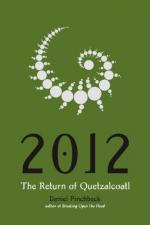|
This section contains 1,069 words (approx. 4 pages at 300 words per page) |

|
QUETZALCOATL was one of the most powerful and multifaceted gods in Mesoamerican religions. The cult of Quetzalcoatl, the "quetzal-feathered serpent," was prominent in central Mexico from at least the time of Teotihuacán (100–750 CE) to the collapse of the Aztec capital of Tenochtitlán in 1521. He was called Kukulcan in the postclassic Maya culture that developed from 1000 to 1521, and he played a prominent role in the organizing of the capitals of Chichén Itzá and Mayapan. In the more than seventy painted, written, and archaeological sources that carry the elements of the Quetzalcoatl tradition, he appears both as a major celestial creator god and as intimately identified with the paradigmatic priest-king Topiltzin Ce Acatl Quetzalcoatl, whose great kingdom of Tula, or Tollan, flourished between 900 and 1100, and who is remembered as a primary source of culture, political order, and religious authority in Mesoamerica. The archaeological and ethnographic records show...
|
This section contains 1,069 words (approx. 4 pages at 300 words per page) |

|


